2011
2015
2016
2017
2018
|
|
|
|
|
Now, that's slow travel! We have finally completed one of our long-term walking projects: from Dan's parents' old house in Finchley to their holiday let in Old Hunstanton.
After finishing my River Rother walk, I had a few days at home before we headed up to Norfolk for a week. We planned to walk four or five days to complete our "every now and then" walking project between London and the north Norfollk coast. The weather was hot at first - too hot to walk on a couple of days, so I ended up going to the beach and swimming in the sea for hours instead! And then, of course, the day we finished was grey and rainy.
I'll pop a few more photos down the bottom of this post, but I thought this would be a good moment to look back over the whole walk - which we started back in 2011, when we'd just moved to London from Australia. We didn't get back to it for a few years after that, but we've been fairly consistent in doing a section since 2015.
2011
Possibly early November 2011. Finchley to High Barnet.
November 2011. High Barnet to Cuffley.
December 2011. Cuffley to Hertford; Hertford to Green Tye; Green Tye to Bishop's Stortford.
2015
October 2015. Bishop's Stortford to Great Chesterford over two days (wild camping overnight). Read a snippet about this leg under "Other adventures" in this post.
2016
October 2016. Great Chesterford to Cambridge; Cambridge to Ely. Read more in a previous blog post, Rivers and Roman roads: An autumn walk in Cambridgeshire.
2017
August 2017. Ely to Littleport.
2018
August 2018. Littleport to Downham Market; Downham Market to King's Lynn; King's Lynn to Little Massingham; Little Massingham to Old Hunstanton.
Some of our other long-term walking projects and incomplete paths include the Grand Union Canal, the Thames Path and the Ridgeway (which we also completed this summer - more to come). A friend recently asked us if this was a common thing to do . . . so, is it? Do you have any walking projects on the go?
2 Comments
Epic post ahoy! (But it's mostly photos - and tweets with photos - so don't be alarmed.) Over summer, we went on a road trip, visited a bunch of National Trust properties, camped a lot, saw several lovely friends and subsisted almost entirely on scones, pizza and instant noodles. It was a pretty great holiday, even if we got the best version of British Summer (i.e. rain) most days.
We recently bought ourselves life memberships of the National Trust (thanks to M&A for the gift). The National Trust owns a whole range of places, from castles and stately homes to countryside and coast, interesting historic houses, follies and factories. Most of these places are open to the public, the larger ones have cafés or restaurants, members get free entry and (usually) free parking. We decided that visiting a National Trust place every day would be a good way of exploring the country during our summer hols. Spoilers: we were right. Herewith, a bit about our trip (places marked with an * are not National Trust).
The South
I always find it funny that English road signs will sometimes point to "The NORTH" or "The WEST" or "The SOUTH" (I don't think I've seen one to "The EAST" before - do they exist?). I don't know what the technical definition of those areas are, but I'm going to divide this post according to them anyway. Essentially, we started in Sussex and did a clockwise loop around England, albeit skipping some major parts and adding a short visit to Wales (and an even shorter, minutes-long trip to Scotland). We didn't visit many NT places close to home, because we'll go to them on weekends and short breaks . . .
Day 1: Barcombe Mills*, Ditchling Beacon, Devil's Dyke, Saddlescombe Farm
Our travels started off with a visit to Barcombe Mills for a walk. Then we headed along the line of the South Downs (Ditchling Beacon and Devil's Dyke) with sunshine and wind and forecasts of storms. Unfortunately, we couldn't stay where we planned on the first night due to a family illness, so we stopped off at a camping field - literally, we couldn't even find the loo! - at Saddlescombe Farm.
Day 2: Worthing Beach*, Mottisfont
The rain didn't let up, so we packed up the tent in the wet (not fun, as it was the first time we'd used this tent since last summer, so we were out of practice) and trundled off over the South Downs to Worthing Beach for breakfast (or morning tea, maybe). I picked a bit of sea kale while we were there, to add to our instant noodles later on. Our National Trust property of the day was Mottisfont, where we arrived just in time for the mediaeval history walking tour. Then it was off to our peaceful, if rather poorly signposted, campsite for the evening.
Day 3: Pepperbox Hill, Myncen Farm*, Hardy's Cottage, Max Gate, Loughwood Baptist Meeting House
We woke to a glorious sunrise and popped out of the tent to pick blackberries for breakfast (probably the best breakfast of our holiday, TBH, see ingredients in the tweet below). We set off across the counties of the south coast, stopping at Pepperbox Hill, following a sign to cider and arriving at Hardy's Cottage near Dorchester just as the rain set in. I've never been a huge Thomas Hardy fan, probably because I read Tess of the D'Urbervilles when I was too young to realise it was a condemnation of societal values and couldn't understand why someone would write something so horrible, let alone why people would choose to read it. However, both the cottage and Max Gate down the road were really interesting spots to find out more about domestic and social life of the period. Did you know people used tea leaves (after brewing them) to polish/stain their wooden floors? We called in at Loughwood Baptist Meeting House before heading to Exmouth.
The South West
We felt like we'd moved properly into different terrain. We drove through the long, lingering Downs-ish hills merging into Salisbury Plain, then suddenly we were in the steep green country of the South West, Somerset and Devon. We were in the area last year, and it felt good to return.
Day 4: Lower Halsdon Farm, Exmouth*, A la Ronde, Exeter*
We had a morning to ourselves, so we took advantage of the lovely weather and walked into Exmouth. Our Airbnb hosts told us about a new path that had been put in through a National Trust-owned farm, so we followed it down to the path that snakes around the estuary, enjoying views across the water and mussel beds. We stopped for a cream tea on the way back, which we ended up sharing with a little orange cat. The main event of the day was a visit to A la Ronde with our friend Rachael. Read about the history of the house here. We went to Exeter for a dinner of delicious vegan and vegetarian pizzas at The Flat.
Day 5: Knightshayes, South Hill
Goodbye, Exmouth! We took back roads slowly up to the north coast of Devon/Somerset, enjoying the views of hills and streams and stopping off at Knightshayes for a couple of hours in the middle of the day. The estate itself looked beautiful, but we spent most of our time inside the ridiculous Gothic-revival house, enjoying the first of many examples of ostentatious interior design. We learnt about linen presses (thanks, chatty volunteer), women's golf and a bit about the local lace-making industry (where the family made their fortune). Then we set off again, up to the remote-feeling hilltop expanses and steep, secluded valleys of Exmoor.
Day 6: Watersmeet, County Gate*
Our pretty campsite was tucked away in a wooded river valley sheltered between the high moors outside Porlock. I tried out my new water shoes with a paddle down the river. It was beautiful, and hard to leave for the day! But leave we did, for a wander along the streams and waterfalls to Watersmeet. Their card machine wasn't working, we didn't have cash and the car was parked a mile or so upstream, so after a quick look around we headed off. We went for a lovely little walk at County Gate, through the bright purple heather and yellow gorse (which they call furze, there).
Day 7: Glastonbury Tor, Costa at Shepton Mallet*, Kennet and Avon Canal at Bradford-on-Avon*
It rained! Are you surprised? Dunster Castle wasn't yet open, so we headed to Glastonbury Tor, somewhere I've wanted to visit for ages. We nabbed ourselves some free street parking and joined the train of folks heading to the summit. Oh my goodness. It rained sideways with such ferocity that one side of us was dripping while the other was quite dry. We could see barely a thing from the top. Then we had to come down, drenching our other sides. We were so wet. We bundled into the car, sitting on towels, and sought refuge in a retail park twenty minutes up the road where we tried to dry things under the hand dryer. Luckily, our Airbnb hosts were beyond lovely and helped us dry out. We even had bath robes! In the evening we went to visit our friend Dru, an artist, poet and engineer who lives on a narrow boat on the Kennet and Avon Canal.
Day 8: Dyrham Park, Bristol*
As we pulled in to the drive at Dyrham Park, I said to Dan, "Don't you feel like we're rich folk on a grand tour, visiting our friends in all their grand houses?" Dyrham is one of those classic National Trust properties - a big house, fancy garden, a cafe and bookshop in the stables and a deer park with spectacular views . We went on the volunteer-lead garden tour and it was fascinating to learn its history and the plans for further restoration. After Dyrham, we headed to Bristol, where we stayed with Allysse & co. Allysse and Emma took us out for some tasty pizzas. Mmm, yum.
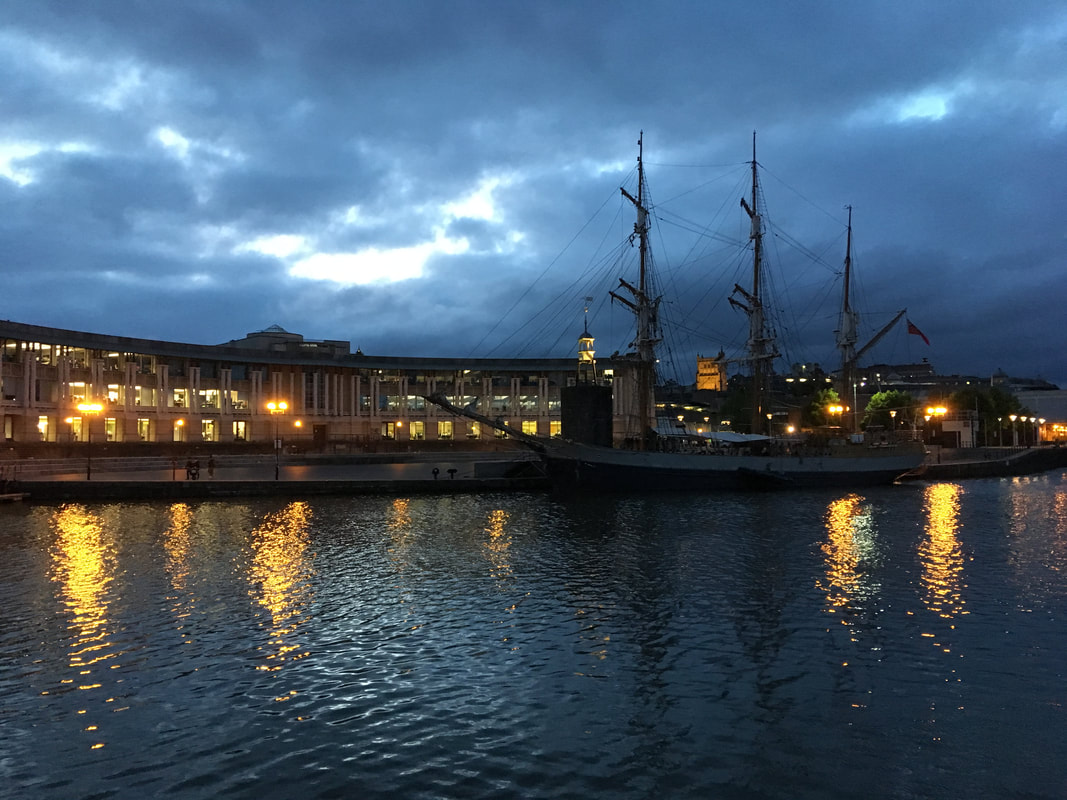
We thought this was the Matthew (replica of the boat sailed across the Atlantic in 1497) but it's the tall ship Kaskelot (restored original).
Day 9: Cheddar Gorge, Wells*
After a relaxing morning, Allysse, Emma, Dan and I drove down to Cheddar Gorge, where we climbed a lookout, had lunch in the (very touristy) village and then walked around the top of the gorge. It's an amazing place! I guess I thought, in the back of my mind, that you don't get "big landscapes" in England - especially in the south. I loved everything about the walk and the company. Allysse and I recorded an intro for Queer Out Here. We saw wild goats . . . and Glastonbury Tor, in the distance, in the sunshine. After a few false starts (including an abandoned pub!), we ended up in Wells for dinner.
Wales
We love Wales (had you noticed?), so we couldn't really go from Bristol to Birmingham without popping in to a couple of our favourite places. It was fun to notice that our DuoLingo and Say Something in Welsh practice has paid off a bit - we could understand a few more signs this time. Gwych!
Day 10: Tredegar House
Allysse had to work, but Emma came with us to Tredegar House on the outskirts of Newport. We had a short wander around the ponds, then popped into the house. Once again, the room volunteers provided entertaining commentary on the history of the house and its owners. Fave quote about a fellow with a pet kangaroo: "As you can see from this photograph, he was gay." We went to a talk about the history of the property from Tudor times to its life as a school and council-run venue. It was warm, I was comfortable, I fell asleep. Sorry, volunteer presenter! We ate scones, dropped Emma at the station then headed on up to an Airbnb in Caerphilly.
Day 11: Lanlay, Caerphilly Mountain*
National Trust places seemed a bit thin on the ground in the immediate vicinity, but we found one: a field. OK, that makes it sound dull, when in reality Lanlay is a series of beautiful riverside meadows that have not been farmed since before WWII. This means the place retains traditional hedges and a huge diversity of wild herbs, grasses and so on - the kind of diversity I'd heard about, but it was another thing to see and truly understand what we've lost elsewhere and what people are working to bring back where possible. There was a sign encouraging people to pull up Himalayan Balsam, so rather than walking we went on a long weeding expedition. We had lunch with lovely friends (and it was a lovely lunch, although I think the soup broke two soup makers?!). After lunch we drove to the top of Caerphilly Mountain for a wander around the common/heath. All in all, an enjoyable day!
Day 12: The Sugar Loaf, Abergavenny*, Pen-Ffordd-Goch*, LLanthony Priory*
Up through the valleys from Caerphilly we went, heading towards a wonderful part of the world - the area around the Black Mountains/Brecon Beacons/Usk Valley/Wye Valley/Vale of Ewyas. First stop: a climb to the top of Sugar Loaf/YFâl. This was great. The climb gradually steepening to the rocky crest. We spent a while enjoying the excellent views and watching the rain jumping peaks towards us - Corn Du, Pen y Fan and Cribyn in the distance, then the nearer hilltops, then the Usk Valley, then . . . it missed us! We popped down to Abergavenny for lunch and over to Pen-Ffordd-Goch/Keepers Pond to find the road we'd seen from Sugar Loaf/Y Fâl. Finally, we drove to the sweet little campsite below the picturesque remains of Llanthony Priory/Priordy Llanddewi Nant Hodni. It felt like it had been ages since we'd camped - days since Exmoor - and it was good to be back in the tent.
The Middle Bits
A.K.A. Birmingham, Warrington and Manchester. (I originally called this section "The Midlands" and Derry told me off. Landscape-wise, it felt like we entered The NORTH only once we'd passed Manchester. And let's be real, Manchester's only about two thirds of the way from the south coast to Scotland!) This section of our trip was based more around seeing friends than any particular National Trust properties - but that's not to say we didn't visit some great places.
Day 13: Gospel Pass (Wales)*, The Weir Garden, Birmingham*
Leaving our campsite after a paddle in the nearby river (cripes, it was freezing!), we headed out over the Gospel Pass - one of my favourite viewing points in the world, I think! We then followed the Wye Valley around to The Weir Garden, set on a steep hillside overlooking the Wye. We'd stopped opposite it while canoeing down the Wye last summer and had filed it away as a place to come back to. Worth it! Then it was on to Birmingham, which we managed to do via quite a green route almost all the way into the city. We went to a pub quiz with our friend Rachael (who put us up for the night, too) where we came equal third - only 1.5 points below the winners. (I contributed only one, incorrect, answer - essentially, I think I lost the quiz for the team. Whoops!)
Day 14: Kinver Rock Houses, Alderly Edge, Warrington*
(A.K.A. the day I had chips for breakfast - classy!) We drove with Rachael to check out the Holy Austin Rock Houses at Kinver. These houses are part cave, carved into the red sandstone of Kinver Edge. People were living here up until the 1960s and the houses are refurbished in a cosy, domestic style along early-mid 20th century lines. Unlike many National Trust places, here visitors are encouraged to pick up the household items, sit in the furniture and feel what home might have been like in these fascinating structures. After most of the day out, we dropped Rachael back in Birmingham headed to our dinner date in Warrington, via Alderley Edge. I was such a fan of Alan Garner's books (these ones) as a kid and had a fantastic experience the first time we came to this area, remembering the books, matching the maps with places and going investigating. This was only a brief stop, but oh, wow, I still feel like I know these woods - and the things that might lurk there. It also made me want to re-read Boneland. Anyway! We had a good time with our friend Derry in Warrington. I had chocolate gnocchi for dessert.
Day 15: Quarry Bank, Manchester*
This was a bit of a terrible day, in that I didn't really eat properly until about 3pm. The less said about that, the better! But Quarry Bank was fascinating. The demonstrations were really informative and helped create a physical appreciation of the place's history - the noise, the dangers, the smells, the speed. We bought a tea towel woven on the machines in the factory and headed off to Manchester. It was such a pleasure to spend time with Sarah and Jit and their six cats (SIX CATS). We had a great walk along the canal into the city centre with Sarah, where we met Jit for a drink in the late afternoon sun before gorging ourselves on yet more delicious pizza.
Day 16: Lyme Park and House
After an amazing breakfast (thanks, Sarah - and thanks also for the amazing picnic lunch and dinner on this day!) we all piled into the car and headed off to Lyme. Another NT property with all the trimmings - deer park, stately home, formal garden, stables, orangery, etc. I got to play the piano (as I had at A la Ronde and Knightshayes) and we heard a talk about one of the owners of Lyme. Dan and I tried on the dress ups at pretty much every NT place where they were on offer, but Lyme was definitely the best. They had a whole room of clothes and volunteer assistants to help you dress and you could put on a complete outfit and wander around the property in it! We saw a few people in full costume around the house. Brilliant!
The North
The North (The NORTH). I can count the number of times we've been north of Manchester on one hand (once to Scotland, once to the Yorkshire Dales, once to the Lake District), so it was great to be back! I think it feels so far away from us down on the south coast that we don't even think about going there on holiday. That's kind of changed after this trip, and I like to think that we'll visit The NORTH more frequently, now.
Day 17: John Rylands Library*, Malham Tarn Estate
Having had a lovely time with Sarah and Jit, we went with them into town and visited the John Rylands Library, where we wandered around an interesting exhibition, ogled the reading room and admired the very cool neo-Gothic spaces (the library has featured in the Harry Potter films). We ate a tasty brunch before setting off northwards, with no precise destination in mind. We wanted to check out Malham Tarn and the rain stopped just in time for a lovely stroll on the boardwalk. We spotted wildflowers and ate wild raspberries -yum! Further and further through the Yorkshire Dales we pootled, checking out a couple of campsites to no avail before stumbling upon a Camping and Caravanning Club affiliated one in Aysgarth, where we settled in for the night.
Day 18: Aysgarth Falls*, Tan Hill Inn*, Hadrian's Wall and Housesteads Fort
We'd never heard of the Aysgarth Falls before, but as we were camped nearby it only seemed right to toddle down for a peek and a paddle. It was a glorious morning, so we made the most of it. We decided to head for Hadrian's Wall in the afternoon, which meant another long drive, down quaint country lanes and up over crumbling moors (there is some seriously bad erosion going on up there). We stopped off for lunch at Tan Hill Inn, a popular spot not only because it's the highest pub in Britain but because the Pennine Way leads right to its door. We reached Hadrian's Wall later than we might have liked, but still had enough time to take in the exhibition as well as Housesteads Fort. It reminded me so much of The Wall in Garth Nix's Old Kingdom series, I was concerned by the lack of wind flutes. Having signed up to the CCC that morning, we checked the app for nearby campsites. As luck would have it, there was one just down the road that had space for us - and they even gave us half a dozen eggs!
Day 19: Wallington, Cragside
After the massive, crunched up hills of Yorkshire, Northumbria seems to stretch itself back out, with longer, lower rises and gentler valleys. Driving through the heather-drenched landscape, we found a sign pointing to Wallington, where red squirrels might be found. Of course, we stopped! An hour in the hide only turned up birds (mainly tits, robins, nuthatches, woodpeckers) and a tiny frog, but it was an enjoyable break. We headed to Cragside in the afternoon. A couple of people had mentioned this as a destination - and no wonder! It was the first home to be lit by hydroelectricity, so there's some interesting engineering history there, but it's also a great house (with the most ridiculous 10 tonne marble fireplace) and a gorgeous estate.
Day 20: Barter Books*, Lindisfarne, Scotland*
The day got off to a bad start. We couldn't find the car keys anywhere (we looked everywhere - the field, the tent, the facilities caravan) and presumed we'd locked them in the boot. We called our insurance to get a locksmith, but he got lost on the way and it took 2 hours for him to arrive. He opened the car, we still couldn't find the keys . . . until Dan went back into the tent, and there they were. Argh! Hungry for breakfast, we found a random cafe in nearby Alnwick - which turned out to be in the most awesome second hand book shop, Barter Books. After breakfast, we headed to the Holy Island of Lindisfarne, parking in the dunes and finishing the trip on foot. It was packed with tourists and the castle was closed, so we bought some mead and walked back, the ghostly moans of the seals drifting across the water on the wind. As we were so close to Scotland, we popped up to cross the border. On the way back to the campsite I had a paddle at Cocklawburn Beach in the dark blue North Sea. The day ended better than it began with a delicious picnic (with mead, natch) in the low evening sunshine.
Back down to the East
And so we began driving south - "downhill" - out of The NORTH . . . it felt like we'd turned the corner and were heading back home. In fact, we reminded ourselves, we still had a week to go!
Day 21: Fountains Abbey
The Unthank sisters brought a tear to our eye as we passed Gormley's Angel. The day's stop was Fountains Abbey, set in the beautiful Studley Royal Water Garden, where we wandered the paths, enjoyed the interpretation timeline, admired the views, did a bit of knitting and of course ate a scone. I haven't mentioned every scone we ate. There were so many! I was quite the contributor (or should I say Sconepal?) to the National Trust Scones Twitter feed. That night we stayed in another CCC affiliated site - our first choice was a cute place that turned out to be wedged between two noisy motorways, but we ended up in a bleak semi-industrial landscape with pylons and smokestacks in the background. But the staff were nice, the food was fine and the showers were warm.
Day 22: Nostell, Sheffield*
Having camped not too far from Nostell, we got to the property early and had a peaceful stroll around the walled garden - and a few spins on the flying fox/zip wire! - before the crowds arrived. We went on an informative guided tour of the house, learning about the owners, architects/designers and collections. Our guide took pains to point out the collection of Chippendale furniture - some of which was horrible, in my non-expert opinion! In the afternoon, we headed to Sheffield to stay with our friends Vic and Jonjo (who have better taste) and went for a drink on a rooftop terrace to soak up some summery atmosphere. The last bit of our trip was shaping up to have much better weather.
Day 22: Tattershall Castle
After a homemade breakfast (thanks, Vic) we were off, heading towards Tattershall Castle. I didn't know what to expect, but I loved it! After seeing a few "in the style of" neo-Gothic or Romantic-mediaeval properties, it was good to get a feel for a space that is solidly middle ages - the big rooms, wide fireplaces, spiral stairways and windows over the moat. Mostly, though, I loved the graffiti, which had been scratched into the stone from the 1700s right through until the present. We heard others tut-tutting about it, but how cool to think of someone's hands running over that precise spot over 200 years ago. (Some of the graffiti was, perhaps, a little less authentic - check the tweet below.) We decided we'd rather not spend a night in the forecast storm, so we pushed on across the lowlands of Lincolnshire, through New York and Boston (yes!) and around the Wash to the comfy bed that awaited us in Norfolk.
In Norfolk: Morston Quay, Titchwell*, Sandringham*
Our road trip proper stopped in Norfolk, where we stayed with family in a holiday house for a while. I went swimming a couple of mornings, we visited Titchwell RSPB reserve a few times, we ate some good food and did some touristy things. Including . . . seeing seals! They were delightful to watch. Our final National Trust place was Morston Quay, near Brancaster. You can listen to the sound of boat rigging in the wind below. We also visited Sandringham (the Queen's house), which made for an interesting comparison with all the NT stately homes we'd seen. You only get to visit a handful of rooms, but they're apparently set up just as they are when Her Maj is in residence. It must be odd to live amongst the collections of stuff from past royals - there's a whole collection of jade ornaments, which I found especially unappealing. You can read a bit more about the interiors in this Country Life article, if you're interested.
And so our National Trust road trip was at an end. Dan and I agreed that it had been a great holiday.
We saw new sights, learnt many interesting things and had a ready-made structure to each day. Car camping was fairly low stress, though next time I would be a bit more organised - we took far too much stuff, probably because before we left we were concentrating on moving house rather than packing for a holiday. The Camping and Caravanning Club membership proved a happy medium between total spontaneity (and the stress that can bring) and complete pre-planning (and the lack of flexibility that can bring). Hopefully we'll use it again over the year. Speaking of memberships, I'd thought by the end of our trip I would be sick of National Trust branded literature and atmosphere, but it wasn't too bad - each place retained enough individual character to intrigue and charm us. We were ready to stop by the end, though. As much as it was enjoyable to pop in to so many different parts of the country, I think next time we'll pick just one or two areas to explore!
Thanks so much to all the folks who put us up, fed and watered us and/or spent time with us: Rachael, Dru, Allysse, Emma, Kate & family, Rachael (another one!), Derry, Sarah, Jit, Vic & family, the Katzes.
The last of my 2016 posts - two months together, as there's not much I haven't blogged already!
We celebrated two fortieth birthdays (not mine!) in November. I was very proud of the ridiculous quantities of decorations I managed to find. I think my favourite was this pirate and sea-themed banner, which is customisable for any age. Genius.
We went for a very windy (but beautiful) walk along the beach from Hastings to Bexhill with a couple of friends.
I might as well share this video of the waves again. I find it quite soothing. Maybe you need soothing, too.
Waves at Bexhill from In Which I on Vimeo.
As the days got shorter and the weather colder, we scaled back to smaller trips in order to get outside without the pressure of completing long walks. We climbed up East Hill in Hastings . . .
. . . and went for a walk near Herstmonceux with our local LGBT walking group.
Later in December, we headed up to Norfolk for a week-long holiday. We stopped off in North London for a night, then broke the next day at Wandlebury. We'd briefly vsited Wandlebury a couple of months before and I wanted to check it out again.
That's it! I quite enjoyed this reflection on what was a pretty good year (personally, if not globally). You can find my other 2016 year in review posts here: January, February, March, April, May, June, July, August, September and October.
(Try saying that five times fast!) We spent a week of winter holidays in Old Hunstanton, a pretty village tucked up in the northwest corner of Norfolk, where The Wash becomes the North Sea. We have several favourite short walks in the area - these are a few of them. I've included GPX files so you can download them if you want, but most of them are pretty easy to figure out for yourself once you're there! They’re all circular or there-and-back strolls that will take 1-2 hours, so they’re perfect for stretching your legs in the morning or for catching a breath of fresh air after lunch. 1. Above and below the Hunstanton Cliffs
Although on paper this walk is pretty much a there-and-back-again kind of affair, the 'there' along the beach is very different to the 'back' along the cliff top. We started in Old Hunstanton, walked up the beach below the famous two-tone cliffs, had a cuppa in Hunstanton at the lovely Norfolk Deli, then wandered back via the lighthouse and old ruins. You could just as easily do it the other way around. (NB: check the tide times if you want to make sure you can get around the bottom of the cliffs.) 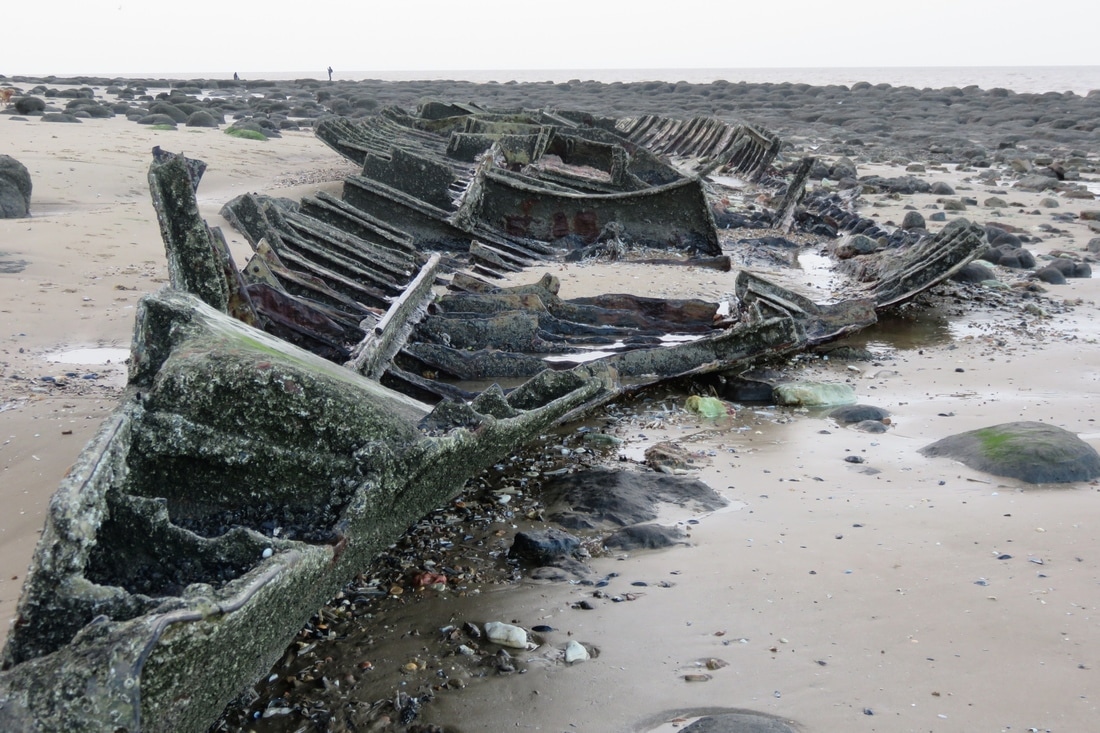 Another diverting feature of the beach, the wreck of the Sheraton, a steam trawler built in 1907 and wrecked in 1947.
2. Up through the Ringstead Downs
Norfolk is famously flat - but it turns out there are some "hills" just out the back of Hunstanton, at Ringstead. We drove out one beautiful frosty morning and parked at the Ringstead end of the downs, following the path straight up between two low, mainly wooded rises. The return walk was much the same, though we detoured up to a lookout over the little park in an old chalk quarry and then down through said park before heading to the car. 3. Beach huts and holiday homes . . . next-the-sea
This walk follows the River Hun (which is not very big, for a river) from Old Hunstanton to Holme-next-the-Sea, with the golf course on your left. At Holme, walk out towards the beach, then follow the Norfolk Coast Path back to Old Hunstanton. You'll see all manner of holiday accommodation, from hotels to beach huts, caravans to fancy houses - especially if you explore the villages at each end. 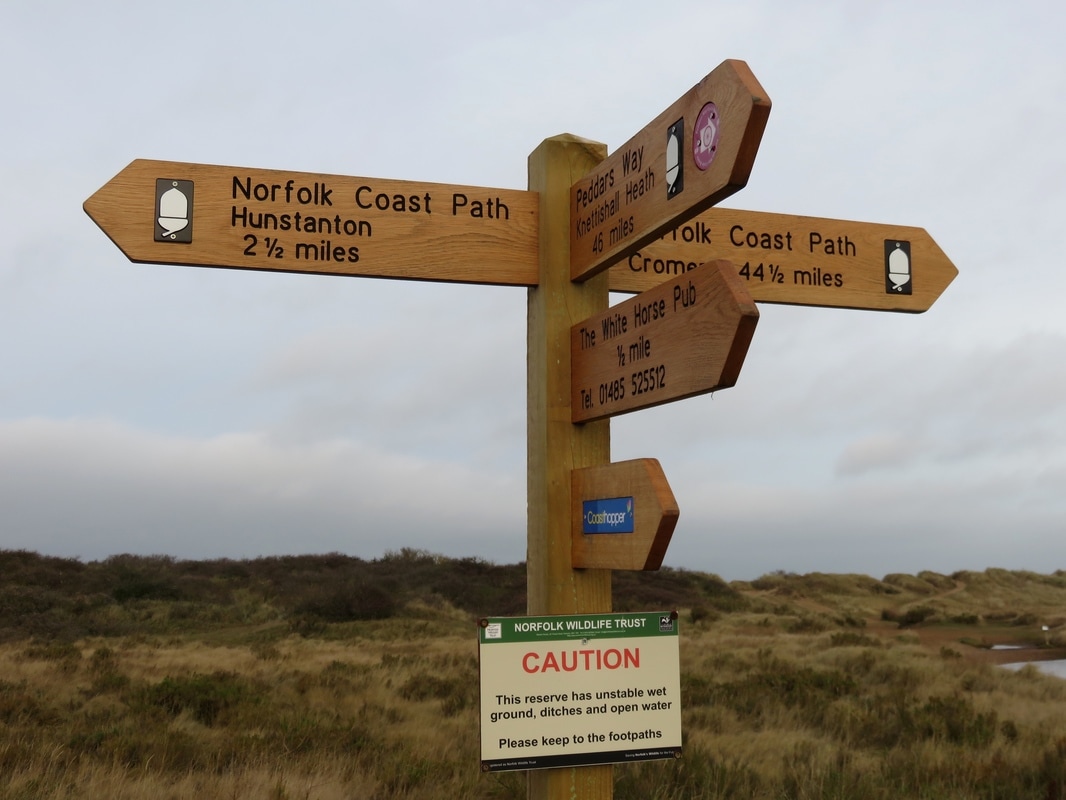 Holme is where the Peddars Way joins the Norfolk Coast Path (they're treated as one national trail). More warning signs! 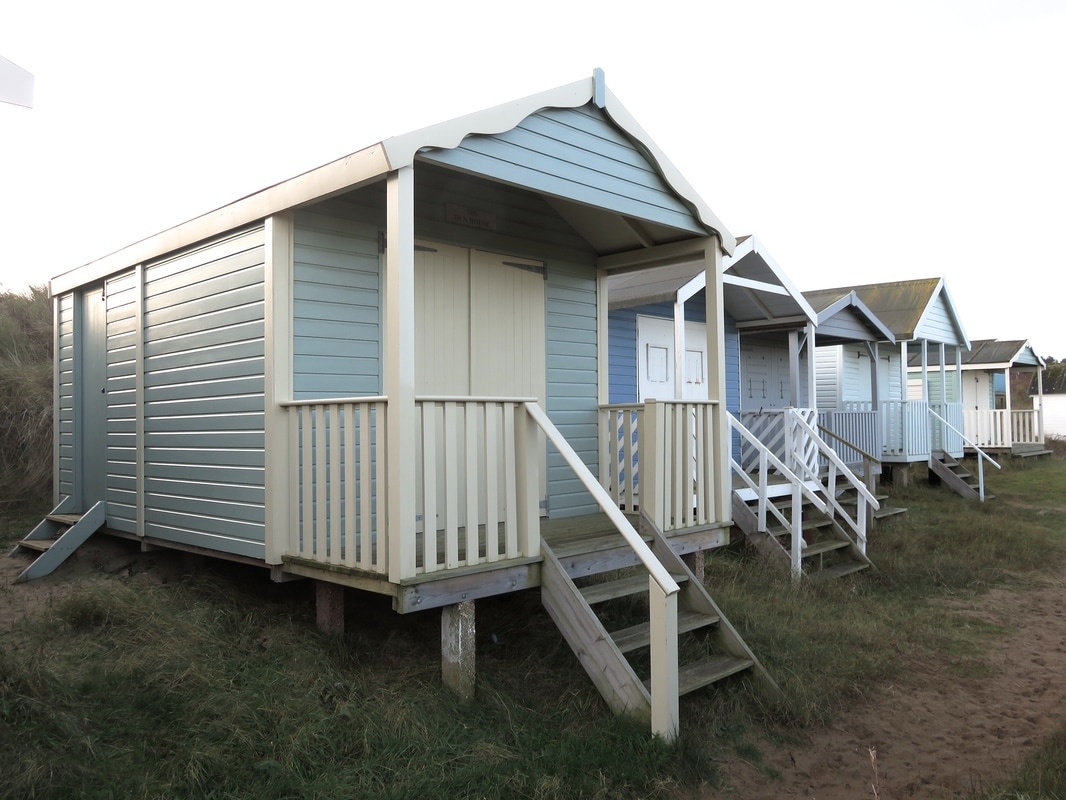 Now we're talking! Beach huts (or beach boxes, if you're from Melbourne). We slept on the verandah of a box like this last December. Not this time! 4. Handsome Holkham Hall
This final walk is a little longer and a bit further east along the coast at Holkham. Holkham is a large, walled estate with a fancy hall, a landscaped and well maintained park, farmland, various monuments and loads of deer. They have a number of suggested walks, both shorter and longer than the one we did. We set off a bit after 9am on Boxing Day and by the time we had finished the carpark, the village and the nearby nature reserve were heaving. We'd chosen a good day to come early!
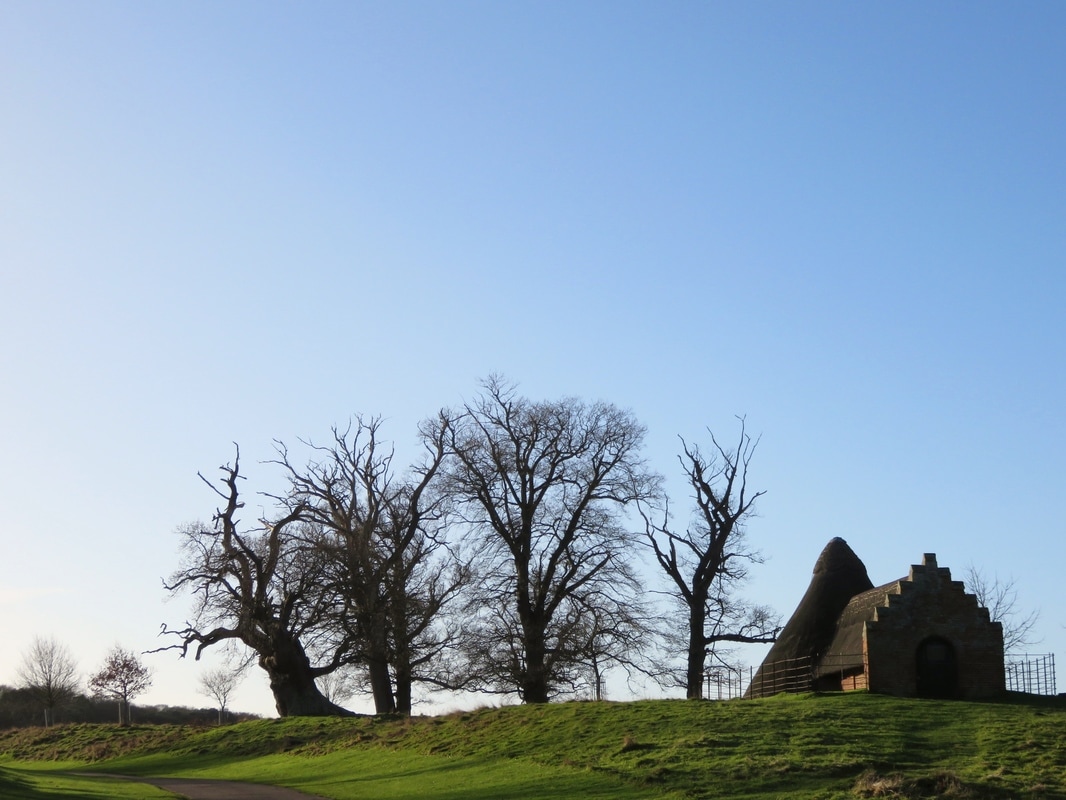 Probably my favourite building at Holkham (and one of the oldest): the ice house. Not spectacular, but very cool. (Cool, haha.) I hope you found those little walks enjoyable to read about - and if you ever visit that corner of Norfolk, I hope you give them a go. Let me know if you do! February's microadventure challenge was set by Emily. She chose wildlife spotting. Inspired by Emily’s species-tracking updates, Dan and I thought we’d keep a log of what we’d seen in our courtyard and beyond. As the month progressed, I also started thinking about why we hadn’t seen more wildlife. In our courtyard
Beyond our courtyard
WildwoodA couple of friends who have joined the microadventure challenge invited us on the spur of the moment to visit Wildwood in Kent. Since I hadn’t managed to spot a (live) badger, I thought this was likely to be my best chance of seeing one. We had an interesting but cold afternoon wandering around the park. We saw a sleeping otter, then later on we were lucky enough to watch one up close being fed. They have amazingly powerful little teeth and jaws that can bite clean through a person’s fingers. There were a number of deer species and a couple of elk (they have bizarre looking faces). I enjoyed watching the big, hairy bison - they looked like pleasant creatures (though I wouldn’t like to have one charge at me - they’re massive). Dan was quite taken by the lynx, I was in a flap over the little owl. We saw lots of other animals, including storks, Bennett's wallabies (did you know there are colonies of wallabies living wild in the UK?), Scottish wildcats, harvest mouse, beavers, eagle owls, barn owls, wild boar, wild horses, egrets, ravens (they are so much bigger than crows!) and wolves. We all spent a long time looking at the edible dormice (which are much bigger than I expected and look almost like sugar glider possums), but that’s possibly because they were inside, where it was warmer. Oh, and we saw some snoozing badgers, too: success! I’m always a bit uncomfortable in places like this. The animals aren’t cooped up in concrete boxes for display like in old-fashioned zoos, but they still don’t have a lot of room to move around in. I know that many of them are rescue animals and are better off here (e.g. Wildwood has just raised enough money to rescue two Bulgarian bears), but I didn’t like seeing the wolves pacing around the fence line of their enclosure, or the raven flying from end to end of its little aviary. Where is the wildlife?
If declining wildlife, birdlife and biodiversity is something that concerns you, you might also want to get involved with a local conservation group. In the UK you could try: RSPB, The Wildlife Trusts, Woodland Trust, Bat Conservation Trust, BTO, Butterfly Conservation Trust, CPRE, High Weald Landscape Trust, Hawk and Owl Trust, Bumblebee Conservation Trust or Buglife. 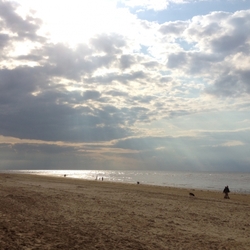 Crepuscular rays near Hunstanton. Crepuscular rays near Hunstanton. In North Norfolk, at the mouth of the Wash, the wind churns the sea into choppy brown peaks and sends clouds scudding across the wide horizon. At low tide, mudflats and salt marshes stretch endlessly, carved through by meandering waterways, spiked with grey and yellow grasses, lightly but thoroughly trampled by flocks of wildfowl and waders. Inland, fields of wheat, corn and sugar beet stretch across the gentle, shallow swells of a landscape punctuated occasionally by dark stands of trees and the grey flint spires of village churches. Life exists here on a thin strip, like the Earth’s crust, sandwiched between sky and stone. Having visited Norfolk several times during the colder, off-peak months, I’ve tended to describe it as flat, bleak and full of birds. But this time, after the best summer in years, I was struck by the abundance and diversity of the hedgerows, streams and tidal marshes. As I explored the area, I couldn’t resist making the most of this wild harvest. . . Foraging for leafy vegetables and herbsStinging nettles and mallow are familiar friends. We found them growing in great quantities along a footpath snaking between coastal villages and we sautéed a few bunches with mushrooms to make a tasty snack. The wild mint we found alongside the nettles went into fresh mint tea. We later found a stream overrun with watercress, but we were out without a bag or container, so I made do with munching on a few peppery leaves. Foraging for berries and fruit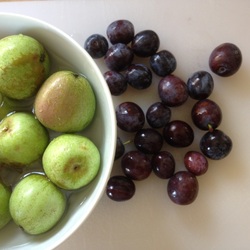 Crabapples and damsons. Crabapples and damsons. Established hedgerows encircled the village we stayed in, offering a variety of fruit. Blackberries are probably one of the most commonly foraged fruits in the UK and we tossed a handful of small but sweet specimens into an apple crumble along with the last cherry plums from a nearby tree. Intertwined with a couple of sloe bushes, and easily distinguishable in such close proximity, I discovered damsons – the first time I’ve found these small plums in the wild. I made a tiny batch of damson jam to experiment, and it was absolutely amazing – tart and flavoursome. We went back later to pick a few more and made them into jelly with some crabapples collected during a bike ride. This wasn’t quite as lively, but it was still good spread on challah toast in the morning. 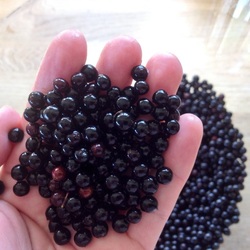 A handful of elderberries. A handful of elderberries. The hedges were dripping with droopy bunches of shiny, black berries on bright red stalks. After checking with some knowledgeable friends on Twitter, I identified them as elderberries. These were completely new to me, so I decided to make something simple to get a feel for the flavour. Alys Fowler in The Thrifty Forager claims elderberries “have a slightly rank taste so it’s always the last jam in our house to get eaten”, but I was not to be dissuaded! I made a tasty (if slightly too sweet) cordial, which was reminiscent of a well-known blackcurrent drink. We drank it with ice out of champagne flutes while sitting in the Norfolk sunshine. . . bliss! Foraging for samphire Marsh samphire. Marsh samphire. My most exciting find, out on those wide, sticky flats, was patch after patch of marsh samphire. I had never eaten samphire before. I snipped a few bits (not sure if it was legal to harvest it, not wanting to disrupt an ecosystem I was not familiar with) and added it raw to a salad. It was gorgeous – tiny, crunchy pockets of salty sea-flavour bursting in each mouthful. (N.B. We later went to Titchwell Manor for a delicious evening meal, during which I was presented with an enormous bowl of samphire. It made my foraging efforts look rather paltry in comparison. . . but food is always tastier when you find it and/or grow it yourself!) Over the course of our holiday, this flat ribbon of North Norfolk became more than a beautifully bleak and bird-filled landscape to me. Through our foraging excursions, I connected with it on a personal scale and felt grounded there in a way I hadn't before. What wild food is in season where you live? Have you got any foraging stories or questions? I'd love to hear them in the comments or on Twitter. |
In which IIn which I do things and write about them In which I tag
All
In which I archive
July 2022
|
||||||||||||||||||||||||||||||||||||||||||||||||||||||||||||||||||||||||||||||||||||||||||||||